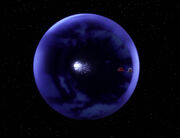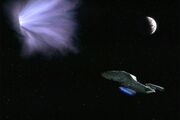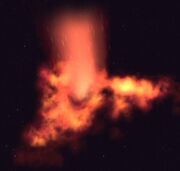(Undo revision 1660847 by 170.185.51.17 (talk)) |
|||
| (7 intermediate revisions by 6 users not shown) | |||
| Line 1: | Line 1: | ||
| − | {{at|xx}} |
||
[[File:Barzan Wormhole.jpg|thumb|Alpha Quadrant aperture of the Barzan wormhole (2366)]] |
[[File:Barzan Wormhole.jpg|thumb|Alpha Quadrant aperture of the Barzan wormhole (2366)]] |
||
[[File:Barzan Wormhole in the Delta Quadrant.jpg|thumb|Delta Quadrant aperture of the Barzan wormhole (2373)]] |
[[File:Barzan Wormhole in the Delta Quadrant.jpg|thumb|Delta Quadrant aperture of the Barzan wormhole (2373)]] |
||
| Line 9: | Line 8: | ||
{{bginfo|This would suggest that natural wormholes in the galaxy, never leave the galaxy.}} |
{{bginfo|This would suggest that natural wormholes in the galaxy, never leave the galaxy.}} |
||
| ⚫ | |||
| − | |||
==Natural wormholes== |
==Natural wormholes== |
||
Wormholes and the possibility of using them for time travel had been recognized by [[Human]] [[scientist]]s since the [[20th century]]. In [[2368]], [[Captain]] [[Jean-Luc Picard]] of the {{USS|Enterprise|NCC-1701-D|-D}} agreed with ''faux'' historian [[Berlinghoff Rasmussen]] that using knowledge gained by means of time travel through a wormhole (for example, in order to save an endangered planet) could allow the "next [[Adolf Hitler]]" or [[Khan Noonien Singh]] to come into being. According to the captain, first year [[philosophy]] students had been asked the question ever since the first wormholes had been discovered. ({{TNG|A Matter of Time}}) |
Wormholes and the possibility of using them for time travel had been recognized by [[Human]] [[scientist]]s since the [[20th century]]. In [[2368]], [[Captain]] [[Jean-Luc Picard]] of the {{USS|Enterprise|NCC-1701-D|-D}} agreed with ''faux'' historian [[Berlinghoff Rasmussen]] that using knowledge gained by means of time travel through a wormhole (for example, in order to save an endangered planet) could allow the "next [[Adolf Hitler]]" or [[Khan Noonien Singh]] to come into being. According to the captain, first year [[philosophy]] students had been asked the question ever since the first wormholes had been discovered. ({{TNG|A Matter of Time}}) |
||
| Line 28: | Line 25: | ||
The [[MIDAS array]] was able to create an artificial micro-wormhole that connected the Alpha Quadrant to the Delta Quadrant, but it was only stable for a brief moment. ({{VOY|Pathfinder}}) |
The [[MIDAS array]] was able to create an artificial micro-wormhole that connected the Alpha Quadrant to the Delta Quadrant, but it was only stable for a brief moment. ({{VOY|Pathfinder}}) |
||
| − | Warp engine imbalances have also been known to create wormholes, as happened to the {{USS|Enterprise|NCC-1701}} in the [[2270s]]. While attempting to intercept [[V' |
+ | Warp engine imbalances have also been known to create wormholes, as happened to the {{USS|Enterprise|NCC-1701}} in the [[2270s]]. While attempting to intercept [[V'ger|an unknown alien]] en route to [[Earth]], [[Captain]] [[James T. Kirk|Kirk]] ordered [[warp drive]] utilized before proper simulations had been completed, causing the ''Enterprise'' to become trapped in a wormhole for a brief period of time. ({{film|1}}) |
{{bginfo|The apparent dissimilarity between the wormhole featured in ''Star Trek: The Motion Picture'' and other wormholes featured in subsequent episodes was somewhat explained in {{VOY|Counterpoint}} as [[Torat]] claims that the term "wormhole" is a layman's term that covers any number of phenomena.}} |
{{bginfo|The apparent dissimilarity between the wormhole featured in ''Star Trek: The Motion Picture'' and other wormholes featured in subsequent episodes was somewhat explained in {{VOY|Counterpoint}} as [[Torat]] claims that the term "wormhole" is a layman's term that covers any number of phenomena.}} |
||
| Line 35: | Line 32: | ||
* [[Bajoran wormhole]] |
* [[Bajoran wormhole]] |
||
* [[Barzan wormhole]] |
* [[Barzan wormhole]] |
||
| − | * |
+ | * Interspatial flexure |
** [[Intermittent cyclical vortex]] |
** [[Intermittent cyclical vortex]] |
||
* [[Micro-wormhole]] |
* [[Micro-wormhole]] |
||
| Line 50: | Line 47: | ||
* [[Transkinetic vector]] |
* [[Transkinetic vector]] |
||
* [[Wormhole effect]] |
* [[Wormhole effect]] |
||
| + | |||
| ⚫ | {{bginfo|In a deleted scene from {{film|12}}, the {{Federation}} was conducting wormhole research within Federation space a [[sector]] away from the [[Klingon Neutral Zone]]. The site of the research was marked on a [[star chart]] displayed at [[Starfleet Headquarters]] on [[Earth]] in the office of [[Admiral]] {{alt|Alexander Marcus}} [http://vimeo.com/72019454]}} |
||
==External link== |
==External link== |
||
* {{NCwiki}} |
* {{NCwiki}} |
||
* {{wikipedia}} |
* {{wikipedia}} |
||
| + | |||
| ⚫ | |||
| ⚫ | |||
[[cs:Červí díra]] |
[[cs:Červí díra]] |
||
| Line 60: | Line 62: | ||
[[ja:ワームホール]] |
[[ja:ワームホール]] |
||
[[nl:Wormgat]] |
[[nl:Wormgat]] |
||
| + | [[pt:Buraco de minhoca]] |
||
| ⚫ | |||
| ⚫ | |||
Revision as of 17:13, 23 October 2014

Alpha Quadrant aperture of the Barzan wormhole (2366)

Delta Quadrant aperture of the Barzan wormhole (2373)
A wormhole is a "tunnel" connecting two separate points in space-time. It consists of two apertures in space-time connected by a conduit outside normal space, through subspace. Since this conduit is shorter than the distance between the two points in normal space, it allows rapid travel between the two points.
If a wormhole was large and stable enough, a starship (or other traveler) could travel through it. A wormhole could also connect two different points in time as well. As wormholes collapse, they become smaller and are known as micro-wormholes. (VOY: "Eye of the Needle")
Before knowing where the Harry Kim wormhole ended, Tuvok stated that there was a 75% chance that it didn't lead to the Alpha Quadrant.(VOY: "Eye of the Needle")
Natural wormholes
Wormholes and the possibility of using them for time travel had been recognized by Human scientists since the 20th century. In 2368, Captain Jean-Luc Picard of the USS Enterprise-D agreed with faux historian Berlinghoff Rasmussen that using knowledge gained by means of time travel through a wormhole (for example, in order to save an endangered planet) could allow the "next Adolf Hitler" or Khan Noonien Singh to come into being. According to the captain, first year philosophy students had been asked the question ever since the first wormholes had been discovered. (TNG: "A Matter of Time")
No known naturally-occurring stable wormholes had yet been discovered in the Alpha or Beta Quadrants. The only likely candidate, the Barzan wormhole, was found to be unstable at its far terminus. However, several relatively stable wormhole-like phenomena have been reported in the Delta Quadrant. (TNG: "The Price"; VOY: "Eye of the Needle", "Night", "Counterpoint")
Artificial wormholes

The Bajoran wormhole

An artificial wormhole opened in 2372

Wormhole distortion
The only currently known stable artificial wormhole was the Bajoran wormhole, created by beings known to the Bajorans as the Prophets, who dwelled within. This wormhole was stable enough for long-term, two-way space travel between the Bajor system in the Alpha Quadrant and the Idran system in the Gamma Quadrant. (DS9: "Emissary")
In the 2370s, the Federation investigated methods of creating artificial wormholes. The project was headed by Dr. Lenara Kahn of the Trill Science Ministry, who eventually developed a workable theory that she tested aboard the USS Defiant in 2372. The technique involved generating a subspace tensor matrix in the 25,000-30,000 cochrane range, and then sending out a magneton pulse using a target drone. The pulse would then interact with the matrix to produce a subspace distortion, which would become an opening in the space-time continuum.
The first test of this technique produced a wormhole that was stable for 23.4 seconds. On the second test, a class-4 probe was launched through the wormhole to simulate the passage of an interstellar spacecraft. However, the probe's shields unexpectedly interacted with the tetryon field, collapsing the wormhole and producing a massive graviton shock wave that heavily damaged the Defiant. (DS9: "Rejoined")
The MIDAS array was able to create an artificial micro-wormhole that connected the Alpha Quadrant to the Delta Quadrant, but it was only stable for a brief moment. (VOY: "Pathfinder")
Warp engine imbalances have also been known to create wormholes, as happened to the USS Enterprise in the 2270s. While attempting to intercept an unknown alien en route to Earth, Captain Kirk ordered warp drive utilized before proper simulations had been completed, causing the Enterprise to become trapped in a wormhole for a brief period of time. (Star Trek: The Motion Picture)
List of wormholes
- Bajoran wormhole
- Barzan wormhole
- Interspatial flexure
- Micro-wormhole
- Möbius Inversion
- Spatial vortex
See also
- Spatial gradient
- Subspace axis
- Subspace instability
- Subspatial contortion
- Temporal variance
- Transkinetic vector
- Wormhole effect
